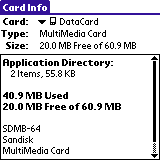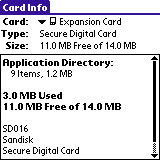The bottom line is that you probably should not pay a premium to own SD instead of MMC. I personally would not purchase an SD card unless the cost difference were $10 or less.
|
Another questions that arises frequently is due to the discrepancy between
the cards "claimed" capacity and what you see when you view it
through your Palm (or a card reader connected to your computer). For
example, if you buy a 64MB card and look at the "Card Data"
application on your Palm, you will see that there is only 60.9MB of space
on the card.
|
||||||||||||||||||
| Where did my missing MB go? | ||||||||||||||||||
|
||||||||||||||||||
|
To understand why your 64MB card has only 60.9MB of space, it is necessary to define what we mean by a MB or megabyte. The "dictionary" definition of MB, and that which is used by software such as Windows Explorer (or the Palm OS) is that 1 Megabyte is equal to 1,048,576 bytes. This is the case because there are 1,024 bytes in a kilobyte and there are 1,024 kilobytes in a megabyte. Remember that computer capacities are measured in powers of 2. A kilobyte is 2 to the 10th power. A megabyte is 2 to the 20th power. Manufacturers who produce storage media, however, use a different definition of megabyte: 1 MB = 1 million bytes. It's a simpler definition to understand, but it causes a large discrepancy when you start talking about large numbers of megabytes. A "64MB card" will hold only 64,000,000 bytes (not 67,108,864 bytes) worth of programs, data, etc. If you divide that by 1024 (the number of bytes in kilobyte), you find that it will hold 62,500 kilobytes. If you divide that number by 1024 (the number of kilobytes in a megabyte), you find that the card will hold only 61MB. The two different definitions "cost" you approximately 4MB on a "64MB card." It is a confusing concept if you're not used to thinking of bytes, kilobytes and megabytes being determined by powers of 2. What this means, basically, is that if you have a 62MB file (say, a video), it will not fit on a 64MB card. Note that there is also a chunk of space that is taken by system files, which amounts to around 100k on an MMC card (which is why the 64MB card shows up as 60.9MB; you start with 61MB and subtract about 100k). These system files seem to be much larger (more than 900k) on SD cards, which is why the screenshot of the 16MB card shows only 14MB capacity instead of 15MB. Also, remember that the discrepancy gets bigger as file sizes get bigger. A 512MB card, which should be available next year, will actually hold only about 488MB worth of data, for a loss of 34MB! The following table shows the "advertised" and "real" amount of space on various sized MMC cards (SD may be a few hundred kilobytes smaller, from what I can tell so far)..
|

